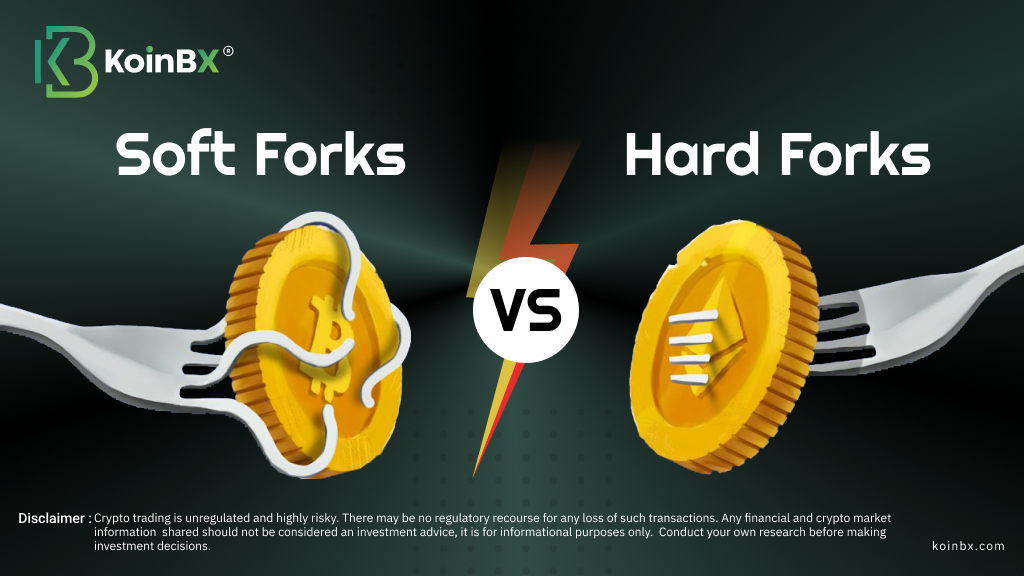Introduction
When we look at blockchain technology, we're just seeing the tip of the iceberg. It is like a digital record that tracks transactions, is updated by agreement, and is secured with cryptography. But a lot is going on behind the scenes that most people, or even those not directly involved, don't know.
One of these behind-the-scenes things is called 'forking' the blockchain network. This is when there's an update to the blockchain and its transactions. To make this happen, most of the developers need to be on board with the update. There are two main types of forks: soft forks and hard forks. But what exactly are these forks, and why do they matter?
This guide explains hard forks and soft forks in simple terms, covering everything you need to know about them. By the end of this article, you'll have a solid grasp of these concepts and understand their impact on the blockchain ecosystem.
Types of Forks
Before diving into the specifics of hard forks and soft forks, it's essential to understand what a "fork" is in the context of blockchain. A fork occurs when a blockchain network's code is modified, creating two or more paths forward.
A hard fork is a significant alteration to the rules and code of a blockchain. This can lead to the creation of a new blockchain or the splitting of the existing one into two separate chains. This usually happens when starting a new crypto project.
A soft fork is a small tweak to a blockchain's rules that creates two versions of the protocol. This means all the nodes on the blockchain can still work together, but some follow the old rules, and some the new ones.
A hard fork is a major upgrade that can make old transactions and blocks either okay or not okay. It forces all the validators to switch to the new version and they can't use the old one anymore. A soft fork is like a software update that allows validators with the old version to still see the new one as acceptable. In real life, a hard fork usually ends up splitting the blockchain into two separate chains. People who had tokens on the old chain get tokens on the new one because they have a shared history. There are many reasons why hard forks happen.
What is a Hard Fork in Blockchain?
It's crucial to have a solid understanding of blockchain before grasping the concept of a hard fork. A blockchain functions as a linked sequence of data blocks, acting as a digital ledger. Each new block is only considered valid once the preceding one has received confirmation from network validators. This means you can trace all data on the blockchain back to the first transaction ever made on the network. This is why the initial block on the Bitcoin blockchain remains visible.
A hard fork marks a permanent split from the latest version of a blockchain. This splits the blockchain, causing some nodes to no longer agree. This creates two separate versions of the network that operate independently. In practical terms, this creates a fork in the blockchain where one path adheres to its existing set of rules while the second path follows a new set of rules. Notably, a hard fork lacks backward compatibility, rendering the old version incompatible with the new one.
Hard forks are often viewed as risky due to the potential for a chain split. If miners and nodes disagree, the network's security weakens, making it easier for attacks to happen.
Why Do Hard Forks Happen?
Hard forks typically occur for several reasons:
Disagreements within the community: One of the most common reasons for a hard fork is a disagreement among the community or developers about the direction of the project. If consensus cannot be reached, a faction may decide to create a new blockchain with different rules.
Security upgrades: Sometimes, hard forks are necessary to implement critical security upgrades that are incompatible with the current version of the blockchain. This ensures the network remains secure and resistant to attacks.
New features and functionality: Hard forks are also used to introduce new features or significant changes to the blockchain. For example, a hard fork might be implemented to increase the block size, improve transaction speeds, or add new smart contract capabilities.
Also Read: A Comprehensive Guide to Blockchain Oracle
What are the Examples of Hard Forks?
Bitcoin Cash (BCH): One of the most famous hard forks, Bitcoin Cash, was created in 2017 due to disagreements over Bitcoin's scalability. The Bitcoin Cash fork increased the block size from 1 MB to 8 MB, allowing for more transactions per block and addressing the scalability issue.
Ethereum Classic (ETC): Ethereum Classic is the result of a hard fork in the Ethereum network following the DAO hack in 2016. The community was split on how to handle the situation, leading to the creation of Ethereum (ETH), which rolled back the blockchain to reverse the hack, and Ethereum Classic (ETC), which continued with the original chain.
What is a Soft Fork in Blockchain?
A soft fork is a backward-compatible update to the blockchain protocol. Unlike a hard fork, a soft fork does not create a new blockchain. Instead, it introduces changes that are compatible with the existing network, meaning that only one blockchain continues to exist after the fork.
With a soft fork, nodes that have not upgraded to the new version of the protocol can still participate in the network, but they may not be able to take advantage of the new features or rules. Essentially, the old and new rules coexist, with the new rules being a subset of the old ones. This allows for a smoother transition and reduces the risk of creating two separate blockchains.
What are the Examples of Soft Forks?
Segregated Witness (SegWit): One of the most well-known soft forks in the Bitcoin network is SegWit upgrade, implemented in July 2017. SegWit introduced a change to the way data is stored in Bitcoin blocks, allowing for more transactions to be included in each block without increasing the block size.
Taproot: Taproot is a recent soft fork in the Bitcoin network, activated in November 2021. It enhances Bitcoin's privacy and smart contract functionality and allows users to combine multiple transactions into a single output.
Difference Between Hard Forks and Soft Forks
AspectHard ForkSoft ForkCompatibilityNot backward-compatible; creates a new blockchain.Backward-compatible; only one blockchain continues to exist.Community ConsensusRequires consensus among participants to avoid a split.Requires a majority of participants to adopt the new rules.ImpactCan result in two separate blockchains and cryptos.No new blockchain or crypto is created.ExamplesBitcoin Cash, Ethereum Classic.SegWit, Taproot.RiskHigher risk of network split and community division.Lower risk; usually smoother transition.
Also Read: The Difference Between Layer 1 and Layer 2 Blockchain
Final Thoughts
Hard forks and soft forks are the fundamental concepts in the blockchain. It shapes the evolution of networks and the cryptos that operate on them. Hard forks can lead to the creation of new blockchains and assets. Soft forks allow for protocol upgrades without disrupting the existing network. Understanding these processes is essential for anyone involved in the crypto space. Blockchain is advancing. We will see more hard and soft forks. These forks will shape how networks develop and adjust to new obstacles.
Whether you're holding Bitcoin, Ethereum, or any other crypto assets, staying informed about potential forks and their implications can help you make better decisions.
Download KoinBX Android App | Download KoinBX iOS App
Disclaimer: Any financial and crypto market information shared should not be considered investment advice. It is for informational purposes only. Conduct your own research before making investment decisions. Crypto trading is unregulated and highly risky. There may be no regulatory recourse for any loss of such transactions.






Comments